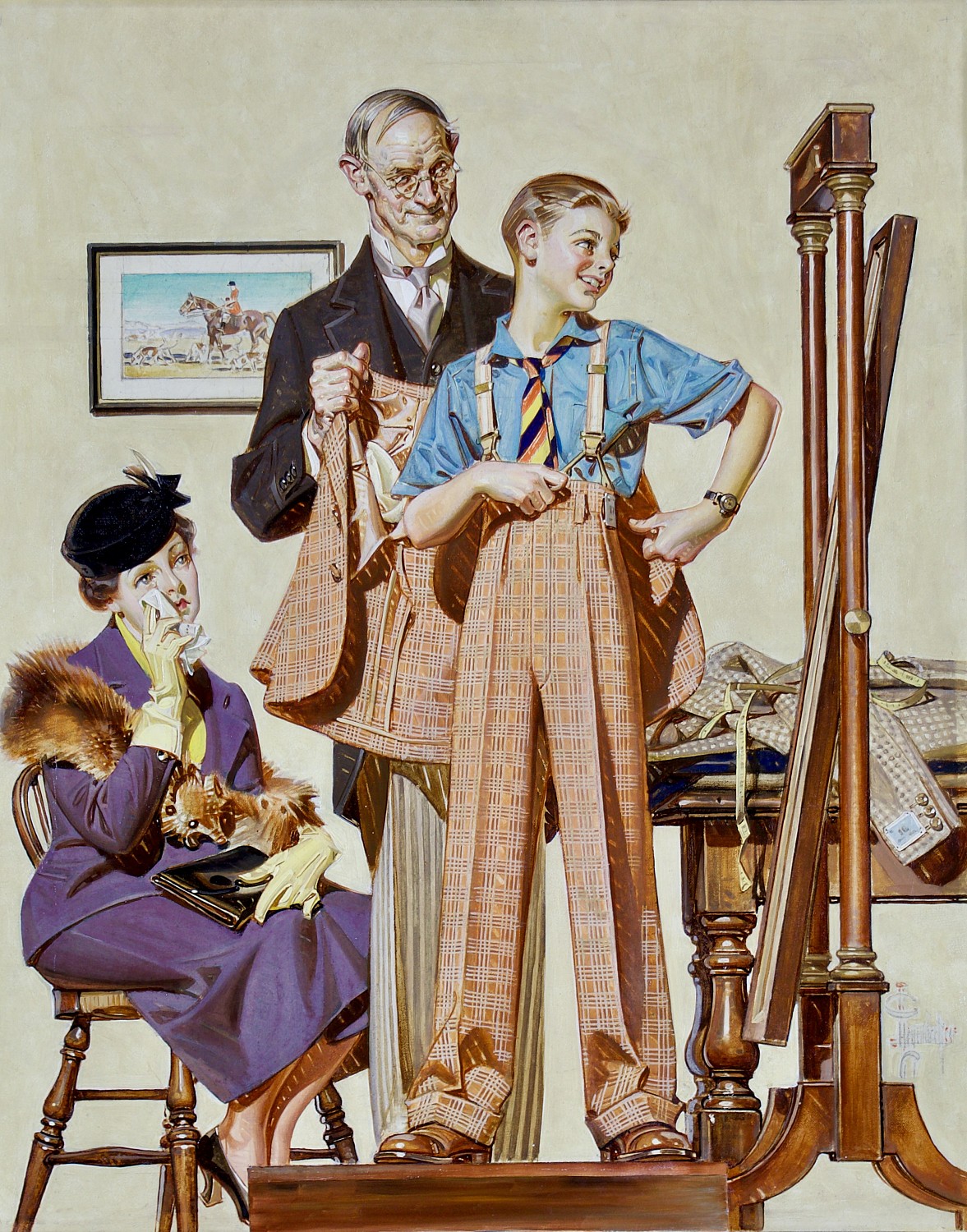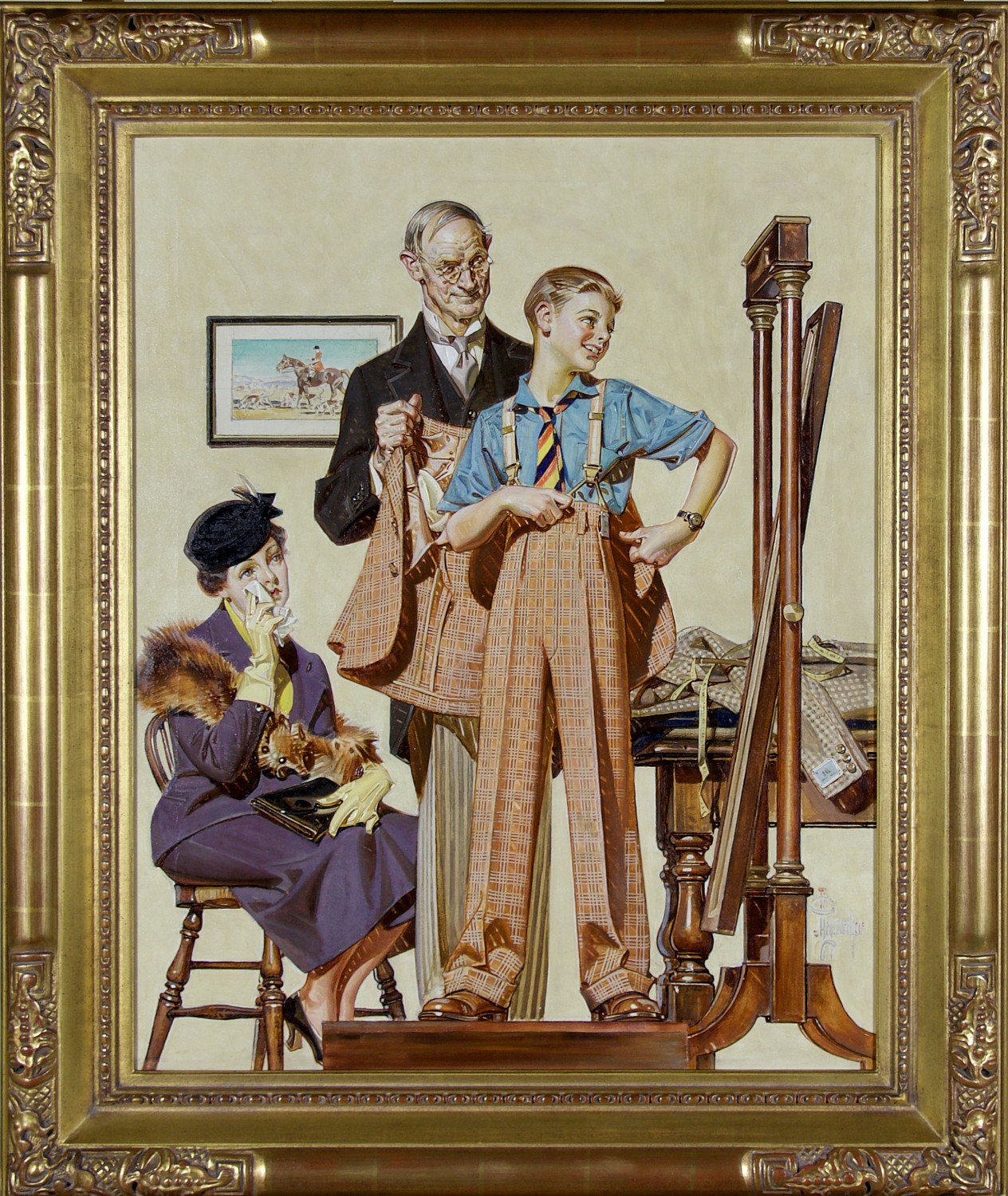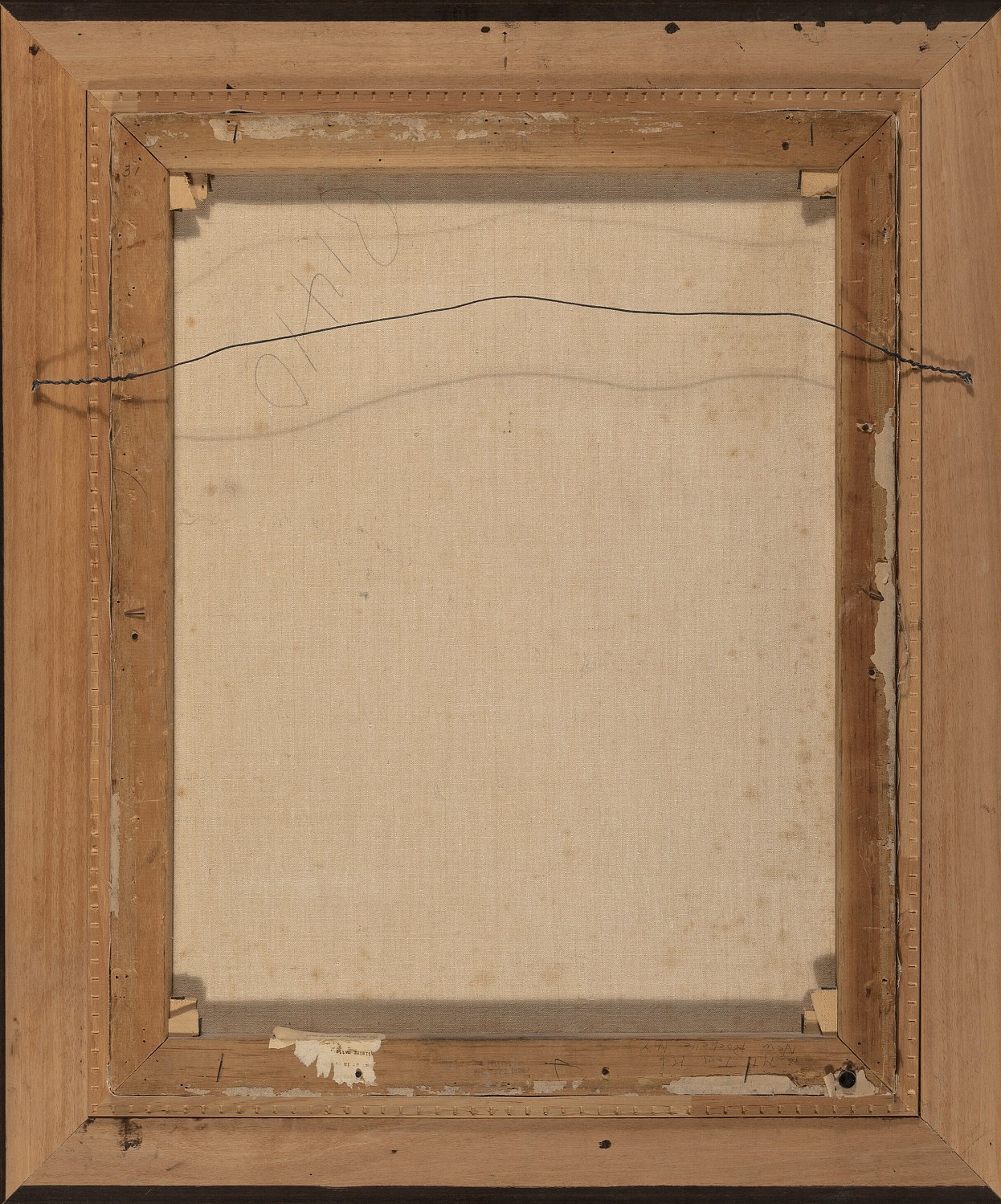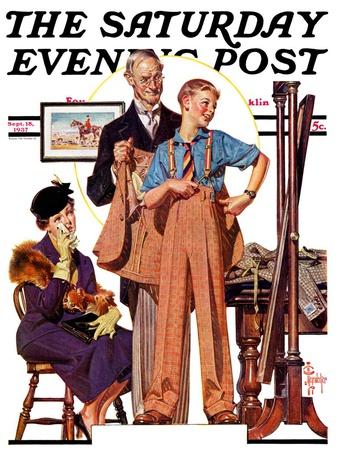"First Long Suit, Post Cover" Lot no. 4567
By Joseph Christian Leyendecker (1874-1951)
1937
27.75" x 22.25"
Oil on Canvas
Signed Lower Right
REQUEST PRICE
PURCHASE REQUEST
The Saturday Evening Post cover, September 18, 1937
One of the most prolific and sought-after artists of the Golden Age of Illustration, J.C. Leyendecker captivates the public with his striking, fashionable depictions of handsome men, glamorous women, and adorable children. Painted in 1937 First Long Suit not only encapsulates the high-fashion, glamorous fantasy world that Leyendecker strove to achieve over the course of his vastly successful career, it also poignantly captures a bittersweet moment that every parent experiences--watching our children grow up right before our eyes.
Born in Montabaur, Germany, Leyendecker came to Chicago with his Catholic family at age eight. He apprenticed to a printer, J. Manz and Co., and then studied with John Vanderpoel at the Chicago Art Institute. In 1896, he won the Century magazine cover competition, which essentially launched him professionally. Two years later, he went to Paris to the Académie Julian with his brother, Francis Xavier, and they learned the "hachure" method of drawing whereby blended shading was not allowed. It was a time when poster art was very popular, and when he returned to America, the artist applied these new methods to his work. With a secret recipe combining oil and turpentine, J.C. and his brother, Frank, perfected a crosshatch method of working in oil paint that gave the speed of pencil and the visual impact of color without the brush going dry.
In the present work, an attractive, fabulously well-dressed mother sits misty-eyed as her young son stands proudly in the mirror with his tailor, happily and proudly sizing himself up in his first 'grownup' suit. Situated up close on the picture plane, the young boy is clearly the star of the narrative. Viewed from a low and heroic vantage point, one cannot help but notice the fineries and the cornucopia of fabrics and textures filling the composition. The scene is skillfully rendered in rich salmons, browns, blues, and buttery yellow, applied with Leyendecker's hallmark cross-hatching technique. The result is a highly refined, wonderfully descriptive moment that young and old alike would wish to emulate.
Published in 1937, the present work was executed during the mature period of the artist's career, only six years prior to his final piece for the Post in 1943. The flawless combination of technical prowess, dazzling color and familial subject matter brand First Long Suit as one of Leyendecker's most ambitious and stylish illustrations to come to market in recent years.
Richard Wyndham Hoffman, The Artist's Model:
J.C. Leyendecker first painted Richard Wyndham Hoffman in 1923, when the artist captured the two-year-old boy’s sense of quiet wonder as he perched on Santa's lap for the December 22 cover of The Saturday Evening Post. But childhood innocence soon darkened for Richard. The following year, his world became consumed by the highly publicized and acrimonious divorce of his parents, the celebrity psychiatrist Dr. Richard Wyndham Hoffman Sr. and the career-driven actress Janet Beecher. Beecher held unconventional spiritual beliefs that led her to convincing her husband to make a disastrous “spirit-guided” investment in her new play – a move that plunged the family into financial ruin.
Years later, after witnessing the boy’s parental struggles playing out in the press, Leyendecker contacted Richard, now 16, and gifted him the original 1923 Santa cover painting, which the artist personally inscribed. At this time, Leyendecker also asked Richard to model for this First Long Suit cover. The artist saw in Richard a resilience beyond his years, capturing a sense of pride and optimism associated with the boy’s transition into manhood. This newfound maturity soon translated into action. As World War II erupted, Richard, at age twenty, joined the Army Air Corps and became a decorated bombardier, completing 26 daring missions.
Richard married before going off to war, but it did not last. His second wife, “Cookie” Warren, was the daughter of the songwriter Harry Warren, who wrote the popular songs “Jeepers Creepers” and “Chattanooga Choo-Choo.” Richard died in 1959 at the young age of 37. (Reference for Hoffman biography: “The Art of the Post: The Little Boy on Santa’s Lap” by David Apatoff, The Saturday Evening Post online, December 13, 2023.)
Explore related art collections: Saturday Evening Post Covers / Magazine Covers / $100,000 & Above / Humor / Family / Fashion
See all original artwork by Joseph Christian Leyendecker
ABOUT THE ARTIST
Joseph Christian Leyendecker was born in Montabaur, Germany, and came to America at the age of eight. Showing an early interest in painting, he got his first job at 16 in a Chicago engraving house on the strength of some larger pictures he had painted on kitchen oilcloth. In the evenings after work, he studied under Vanderpoel at the Chicago Art Institute, and saved for five years to be able to go to France and attend the Academie Julian in Paris.
Upon his return, as a thoroughly trained artist with immense technical facility, Leyendecker had no difficulty in obtaining top commissions for advertising illustrations and cover designs for the leading publications. His first Post cover was done in 1899, and he did well over 300 more during the next 40 years. Among the most famous of these was his annual New Years Baby series.
His advertising illustrations made his clients famous. The Arrow Collar Man was a byword for the debonair, handsome male, and women wrote thousands of love letters to him in care of Cluett Peabody & Company. His illustrations for Kuppenheimer Clothes were equally successful in promoting an image of suited elegance. He was elected to the Society of Illustrators Hall of Fame in 1977.A major retrospective exhibition of Leyendecker's work was mounted at the Norman Rockwell Museum in Stockbridge, Massachusetts, in 1997-98.
Joseph Christian Leyendecker was born in Montabaur, Germany, and came to America at the age of eight. Showing an early interest in painting, he got his first job at 16 in a Chicago engraving house on the strength of some larger pictures he had painted on kitchen oilcloth. In the evenings after work, he studied under Vanderpoel at the Chicago Art Institute, and saved for five years to be able to go to France and attend the Academie Julian in Paris.
Upon his return, as a thoroughly trained artist with immense technical facility, Leyendecker had no difficulty in obtaining top commissions for advertising illustrations and cover designs for the leading publications. His first Post cover was done in 1899, and he did well over 300 more during the next 40 years. Among the most famous of these was his annual New Years Baby series.
His advertising illustrations made his clients famous. The Arrow Collar Man was a byword for the debonair, handsome male, and women wrote thousands of love letters to him in care of Cluett Peabody & Company. His illustrations for Kuppenheimer Clothes were equally successful in promoting an image of suited elegance. He was elected to the Society of Illustrators Hall of Fame in 1977.A major retrospective exhibition of Leyendecker's work was mounted at the Norman Rockwell Museum in Stockbridge, Massachusetts, in 1997-98.
Kent Steine







